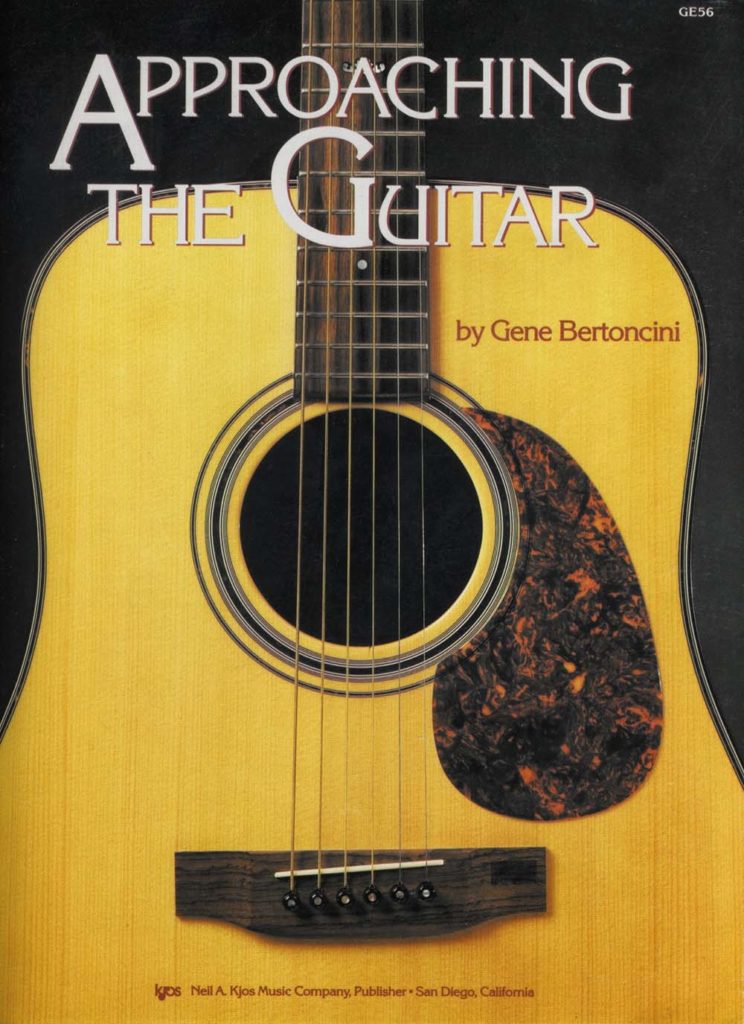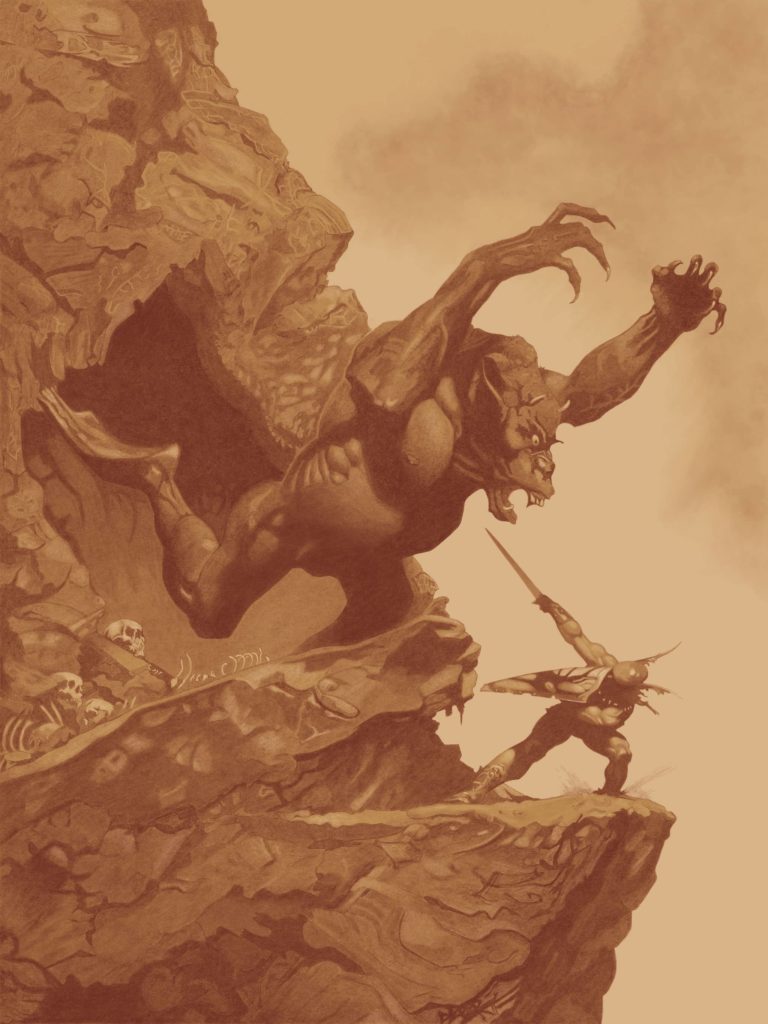Table of Contents
Book Review: “Approaching the Guitar” Gene Bertoncini
Gene Bertoncini is one of the most underrated guitarists around today. His mastery of the instrument in both jazz and classical idioms is well noted. So, it is of no surprise that his excellent book has also flown under the radar. Let’s change that!
Approaching the Guitar

Having seen Gene Bertoncini live, up close, in a small intimate club, I was well aware of his prowess on both his nylon string Buscarino and his D’Angelico archtop. However, after the show when I asked him if he had “Approaching the Guitar” for sale (I had heard of it, but was unable to find a copy), sadly all he had were his CD’s, which I already owned (My favorite is, “Body and Soul”). When I later found a copy online, I immediately purchased it, and looked forward to seeing what his approach to guitar would be, from both a playing, and teaching, perspective. Let’s take a look.
Approaching the Guitar: Table of Contents
The 88 page book is spiral bound, thus making it easy to layout for study, and features a nicely organized “Table of Contents”. The book is divided into 13 chapters, and are progressive in nature. The subjects covered are:
Horizontal Chromatic Studies
Vertical Chromatic Studies
Horizontal Major Scales
Vertical Major Scales
Reading and Writing Studies
Two String Studies
Three String Studies
Four String Studies
Arpeggios
Upper Structure Possibilities
Scales
Intervals and Patterns
Creative Studies: The Combination of Linear and Harmonic Knowledge
Horizontal Chromatic Studies
These are simple four note groupings played chromatically up the neck on one string, with the emphasis on a smooth transition between positions. It is to be practiced on each of the six strings. They should be considered as warmup exercises.
Vertical Chromatic Studies
This study involves the same chromatic grouping as above, however, they are played within a position and across all six strings. These are also considered warmup exercises.
Horizontal Major Scales
This is a fairly popular method embraced by the likes of Pat Metheny, Mick Goodrick and Jim Hall, and it focuses on playing a major scale up and down a single string. It is to be practiced on all six strings individually.
Vertical Major Scales
These are the more common positional major scale fingerings that most players are already familiar with. This and the previous studies are geared more for the “beginner”, though could help “fill in the gaps” for self taught intermediate guitarists.
Reading and Writing Studies
This is a somewhat unusual section. You are first instructed to write a random string of diatonic notes on one string and the proceed to play them evenly as whole notes, making sure to smoothly connect them, regardless of the jump in position.
Then it proceeds to random altered notes not related to any particular key on one string and practice them in the same manner as above.
Although I understand the concept behind this, I found it easier to use the Tommy Tedesco method of just taking a piece of music and turning it upside down and reading it that way.
Next up is taking key harmonic notes (I, III, V, VII) and playing them on one string. This is an interesting approach of playing arpeggios. Again, this is to be done on all six strings.
And while the above are approached in a horizontal manner, the next section uses the same techniques, except now applied with a vertical/positional approach.
Two String Studies
While the previous sections could be considered to be of a more introductory nature, this starts the more “intermediate” section of study, with studies focusing on 2-4 strings.
This section starts off with Horizontal Thirds on two strings, meaning that the interval of a third is played on adjacent strings. This is done for all string sets. Example: strings 1&2, 2&3, 3&4, 4&5 and 5&6.
The second approach uses wider intervals, with fourths and fifths being played on adjacent strings, as mentioned above, and sixths and sevenths using the 1&3, 2&4, 3&5 and 4&6 string sets.
Approach #3 introduces “classical” variations to be use with all of the aforementioned intervals. Example: for the interval of a third you would play “C then E and then back to C”, and applying this pattern to all of the intervals.
Approach #4 is playing the intervals simultaneously instead of as individual notes.
Approach #5 is playing the aforementioned intervals in a position. Think of it as a playing them within the common two octave major scale fingering.
Three String Studies
The Three String Studies consist of four different approaches.
Approach #1 has you playing thirds and fourths across three strings. As per the previous approaches, these are to be practiced with all of the three string sets (ex. 123 234 345 456)
Approach #2 introduces a rhythmic variation of Approach #1.
Approach #3 is a “classical” variation of Approach #1, with the use of a,m,i right hand fingerings. Since I am a fingerstyle player, I used this Approach instead of #1, which was geared towards using a pick.
Approach #4 is Simultaneous Intervals. This section starts out with the use of triads and quartal voicings and moves onto more “exotic” ones using different interval combinations. There are some interesting combinations to be discovered along the way.
Four String Studies
This section obviously moves away from intervals and triads and moves onto seventh chords.
Approach #1 introduces “common” voicings of Maj7th, Dom 7, m7th, m7thb5 and Dim 7th with closed, open and spread voicings.
Approach #2 focuses on the inversions of the previous 7th chords using open and spread voicings.
Approach #3 uses a classical arpeggio technique to play the notes of the chord individually. He also recommends playing the bass note first and playing the rest of the chord simultaneously with your remaining fingers.
Approach #4 is about harmonizing a scale to the seventh degree. Open and spread voicings are used.
Arpeggios
Using the previous 7th chords, we are introduced to two approaches for practicing arpeggios.
Approach #1 – Vertical
This approach uses a pattern that is applied to the specific arpeggio and when completed is replayed by starting on the next highest note in the arpeggio, while maintaining the aforementioned pattern.
Approach #2 – Horizontal
This time the previous arpeggios are all played on one string. This is done for each of the six strings.
Upper Structure Possibilities
This section of the book starts to deal with more advance harmonic concepts, including chords with extensions and such.
Approach #1 Fourths in Voicings
Here we are introduced with stacking fourths to form a four note chord. This is done on each of the three sets of four strings (1234, 2345 and 3456)
Approach #2 The Lydian Scale
The Lydian scale and its related chords are shown here.
Approach #3 Minor Studies Using Quartal Voicings
The quartal theory is continued here, this time applying it to minor chords.
Approach #4 Chord Qualities and Available Notes
This is more of a theoretical, rather than a “hands on approach” to chord qualities.
Approach #5 Harmonized Chord Tones
This is an excellent section for those interested in chord melody and harmonization. The initial examples are broken down into three steps and the reader is shown how to apply the process to several chord types. This is followed by some examples of the technique. This is one of the more interesting sections in the book.
Approach #6 Diminished Chord Ideas
This approach deals with diminished chords and altering them to form altered dominant voicings. This is similar to Pat Martino’s approach, for those familiar with his concepts.
Scales
This section starts of by showing various scales and modes in the key of C, as well as the key of each mode starting on its root. Then it moves onto Pentatonic and Symmetrical scales.
Approach #1 Horizontal
This approach takes the aforementioned scales and has the player play them on the high “E” string. First a chord is played and then the corresponding scale on the one string.
Approach #2 Vertical
With this approach a chord is played at the start and the notes of the scale are played from the bass note of the chord/scale and continues up the scale in the position and end on a chord of a similar voicing as the initial one.
Approach # Pentatonic Scale Ideas
The actual playing of the scales is similar to the above, however, here he goes into expands upon their usage by relating to them in a harmonic notion related to a corresponding dominant 7th chord.
Intervals and Patterns
This is similar to the earlier section on two and three note studies, however, instead of using the C major scale, now you are going to use Melodic Minor and the other scales from the previous sections.
Approach #1 Horizontal Scales in Intervals
Approach #2 Horizontal Patterns
Approach #3 Vertical Scales in Intervals
Approach #4 Vertical Patterns
Creative Studies: The Combination of Linear and Harmonic Knowledge
Approach #1 Harmonized Scales to the 9th and 11th
This approach harmonizes a C major scale, first up to the ninth and then up to the eleventh, each time leaving out the fifth.
Approach #2 Note/Key Relationships
Here a specific note is chosen and then it is analyzed against keys. Example: F# is its own root, it is also the 2nd/9th of E, the Maj 7th of G, etc. This is then applied to specific chord voicings.
Approach #3 II-V-I Progression
Using previous material, a four step method is applied and various soprano voiced chord voicings are used.
Approach #4 Song Forms
This is the culmination of the previous approaches. A progression is chosen, in this case a I-VI-II-V-I, and for each measure a soprano note is chosen for each chord. Then using the soprano note as a focal point, a melodic line is formed by playing/writing notes that connect the focal points. Afterwards you compose a chord melody of the material.
Further examples using a more extended progression include: having the same note as the top note of each chord, keeping the same chord degree as the top note, ascending lines it the top voice and descending lines in the top voice.
As this is the most advanced material in the book, it is a suitable section to end the book.
Summary
There is an excellent range of material in this 88 page book and its appeal will be to players of all levels. For the beginner there are some simple studies that will help in their initial development of playing, while providing further material for future studies. For the intermediate player there are many topics and approaches to help them on their journey towards becoming advanced. And even advanced players will find suitable material to keep them busy and help further develop their playing. Quite impressive for such a concise book.
Players of all levels will want to start at the beginning of the book and work their way through it in order, as the material is closely related in terms of how to progress. An advanced student can skip over some of the early material, however, there is enough points of interest, that reviewing them will only be to your advantage.
Due to the range of quality material presented, I’m a little surprised that this book has flown under the radar for so long. There’s a lot of interesting things to work on, and the fact that it is all presented in such a concise manner is something of note.
As a noted chord melody/solo player, it should come as no surprise that Bertoncini tailors the material towards the more harmonic side of the musical equation. For those looking to build a solid harmonic foundation, this would be a book worth looking into. Although it lacks the “intensity” of books like Van Ep’s “Harmonic Mechanisms” or Goodricks “Chord Almanacs”, it does provide a wealth of distilled information in the context of 88 pages, and is more suited towards providing the groundwork for more advanced studies.
Much of the material is going to take some time to fully absorb at the level that it aspires towards, but in doing so, the reader builds a more intense and personal understanding of the task at hand.
One of the more unique aspects of the book is the use of material that is played on one string at a time. Although other books have touched on this approach, Bertoncini devotes a lot of space towards being able to see/hear scales, arpeggios and intervals on individual strings.
All of the Approaches offer something of interest, and depending on what you are looking for, some will appeal to you more than others. When you complete the book you will have a firmer understanding of the harmonic aspects of the guitar and how each of them can be absorbed into your playing. Due to the concise nature of the book, this is an excellent tome for those who have a limited amount of time to practice, yet are seeking out material that is beneficial for the amount of time they do have.
Recommended
Final Words
As always, I’d like to take a moment to thank everyone who has purchased my book! I appreciate your interest, and support, and I look forward to hearing what you do with the material!
I’ve again enclosed a recent master study drawing that I did. This time it’s Frank Frazetta’s painting, “Cave Demon”, using Procreate on an iPad Pro, with an Apple Pencil 2.






0 Comments